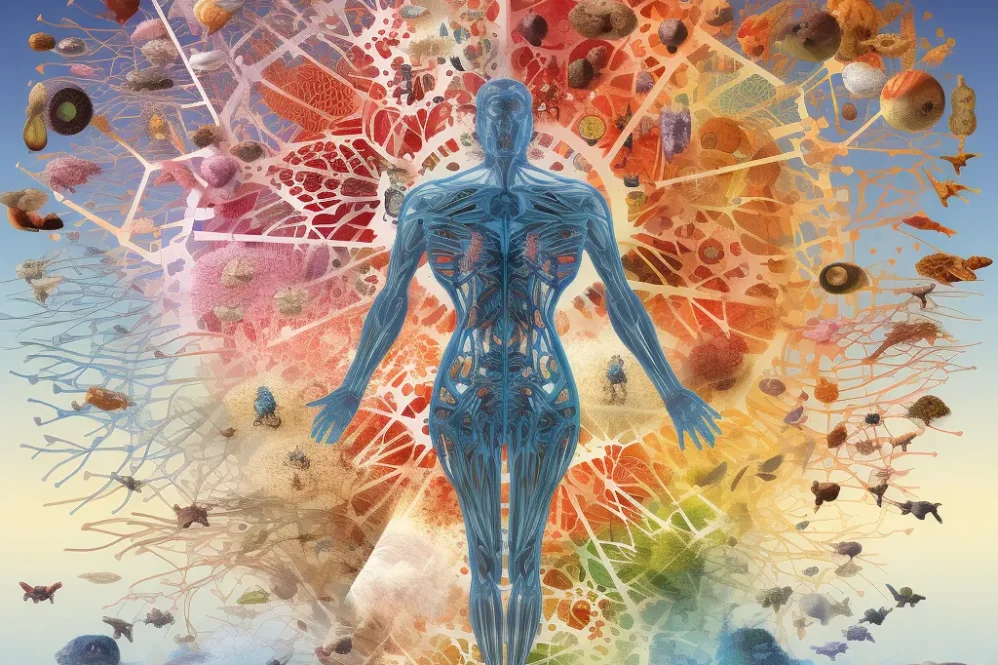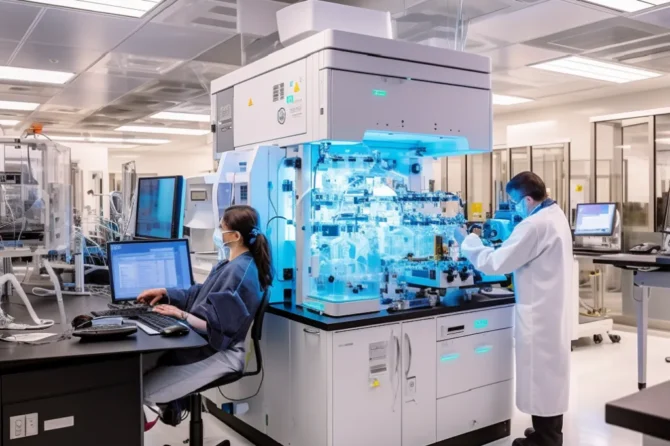Abstract
The field of longevity medicine is indeed experiencing a remarkable revolution in 2023, propelled by groundbreaking discoveries and remarkable advancements in research. These revelations are illuminating the intricate biological processes underlying aging, presenting promising intervention avenues, and painting a picture of a future where extended lifespans are coupled with an increased duration of robust health. Within the scientific community, a diverse array of strategies is being unveiled, spanning from cellular rejuvenation to innovative epigenetic therapeutics, all with the shared goal of mitigating age-related decline and associated diseases. This article delves into the forefront of longevity medicine research, accentuating the most recent strides and their profound implications for both human well-being and the extension of lifespan.
As researchers delve deeper into the mechanisms governing aging, they’re uncovering an assortment of molecular pathways and genetic factors that intricately regulate this complex process. One particularly exciting area of focus revolves around cellular rejuvenation. Scientists are elucidating the roles of various cellular components, including mitochondria and telomeres, in influencing the rate of aging. These investigations have prompted the exploration of potential interventions that could rejuvenate aging cells, revitalizing their function and potentially slowing down the overall aging process.
Moreover, the realm of epigenetics is proving to be a treasure trove of opportunities for longevity medicine. Epigenetic modifications, which dictate how genes are expressed without altering the underlying DNA sequence, play a pivotal role in aging and age-related diseases. Researchers are actively investigating ways to manipulate these modifications to promote healthier aging. This includes strategies to reset epigenetic marks to a more youthful state, effectively “reprogramming” cells to behave in a manner reminiscent of their younger counterparts.
The implications of these advancements extend far beyond the realm of basic science. With each new discovery, the prospect of extending not only lifespan but also healthspan—the period of life spent in good health—becomes more tangible. Imagine a future where individuals can enjoy their later years with the vitality and vigor of their youth, free from the burdens of age-related chronic illnesses. This transformation could revolutionize healthcare systems, redirecting resources from the treatment of diseases to the enhancement of wellness and preventive measures.
However, as with any revolutionary breakthrough, challenges and ethical considerations accompany the excitement. Longevity medicine raises questions about the equitable distribution of these interventions, the potential impacts on society and the environment, and the definition of a “good” or “desirable” lifespan. Striking a balance between scientific progress and responsible implementation will be essential to ensure that the benefits of longevity medicine are accessible to all segments of the population.
Introduction:
The longevity medicine quest for extended and healthier lifespans has kindled a scientific revolution of unparalleled magnitude, characterized by breathtaking breakthroughs and transformative revelations within the realm of longevity medicine. In this ambitious pursuit, the year 2023 emerges as a pivotal juncture, casting a spotlight on the remarkable strides that scientists are taking to unravel the mysteries of aging and chart new courses toward elongating human existence while simultaneously enhancing the quality of life. From intricate cellular mechanisms to pioneering molecular interventions, researchers are painstakingly decoding the enigmatic intricacies of longevity medicine, ushering in a new era where the aging process is not merely comprehended, but also proactively managed and optimized.
At the heart of this scientific awakening lies an intricate tapestry of research endeavors that collectively shape the landscape of longevity medicine. The exploration of fundamental cellular processes has unveiled a treasure trove of insights into the underlying mechanisms governing aging. From telomeres that guard the integrity of DNA to mitochondria that power our cellular machinery, these intricate components are emerging as focal points of longevity medicine intervention. By deciphering the role of these cellular elements in the aging process, scientists are devising strategies within longevity medicine to bolster their function, potentially slowing down the relentless march of time on our bodies.
Zooming in even further, the captivating world of molecular interventions is captivating the imagination of researchers and enthusiasts alike within longevity medicine. Epigenetics, the study of changes in gene expression that occur without altering the DNA sequence, has emerged as a linchpin in the quest for longevity medicine. Through the manipulation of epigenetic marks, researchers within longevity medicine are exploring the tantalizing prospect of “reprogramming” cells to exhibit youthful behavior even in advanced age. This revolutionary approach within longevity medicine holds the potential to not only extend lifespan but also to enhance healthspan—the period of life characterized by optimal health and vitality.
The ramifications of these groundbreaking endeavors within longevity medicine ripple far beyond the confines of laboratories and research institutions. The realization of extended, vibrant lifespans within longevity medicine would redefine the very fabric of society, touching on everything from healthcare systems and retirement policies to intergenerational relationships and personal aspirations. The prospect of a future where age-related ailments are relegated to the annals of history, and individuals can enjoy prolonged periods of vitality within longevity medicine, fuels an era of unprecedented optimism.
However, as with any scientific advancement of such magnitude within longevity medicine, a tapestry of ethical considerations and societal implications unfolds alongside the excitement. Questions about the equitable distribution of life-extending technologies within longevity medicine, the potential strains on resources and the environment, and the cultural constructs surrounding aging and longevity all come to the forefront. Striking a harmonious balance between the pursuit of scientific progress and the ethical deployment of these interventions within longevity medicine becomes imperative to ensure that the benefits are shared across diverse populations.
In summation, the year 2023 emerges as a pivotal chapter in the ongoing narrative of longevity medicine—a chapter characterized by an intricate interplay of scientific breakthroughs, technological advancements, and ethical contemplation within longevity medicine. The pursuit of unraveling the secrets of aging and extending the human experience is a profound journey that transcends individual lifetimes within longevity medicine. As we traverse this uncharted territory within longevity medicine, armed with knowledge and guided by responsible stewardship, we have the potential to reshape the course of human existence within longevity medicine, turning the pursuit of longevity medicine into a catalyst for a more vibrant, healthier, and harmonious world.
The Latest Advancements in Longevity Medicine Research:
The study titled “Multi-modal profiling of peripheral blood cells across the human lifespan reveals distinct immune cell signatures of aging and longevity” represents a pivotal leap in our comprehension of the connection between immune system composition and the intricate processes of aging. Spearheaded by a team of researchers funded by the NIH, this comprehensive investigation delved into the world of immune cells by meticulously analyzing over 16,000 of them. Their aim? To unravel the mysteries of how our immune systems evolve over time and how this relates to the pursuit of longevity.
To achieve this, the researchers harnessed the power of single-cell RNA sequencing, a cutting-edge technique that allows the genetic information within individual cells to be mapped out in exquisite detail. By employing this technology on both centenarians and younger individuals, they unearthed an array of distinctive immune profiles that set centenarians apart. Of particular note were heightened levels of B cells and a reduced presence of T helper cells in centenarians. These unique patterns strongly suggest that the immune system in individuals who have lived for a century possesses a finely tuned balance, possibly contributing to their longevity.

Perhaps the most intriguing revelation was the unexpected immune response pattern observed in centenarians. This distinctive pattern hints at more rapid and efficient defense mechanisms against diseases. But the intrigue didn’t stop there. The study uncovered specific genes associated with DNA damage repair—a process crucial for maintaining cellular health—and even discovered previously unexpressed genes exclusive to centenarians. These findings together underscore the undeniable role of immune resilience in the intricate tapestry of longevity. Moreover, they serve as a rallying call for further inquiries into the intricate interplay between immune function and the aging process, offering a multitude of avenues for future exploration.
The study titled “Gene expressions associated with longer lifespan and aging exhibit similarity in mammals,” undertaken by Japanese researchers, paints a fascinating portrait of the commonalities that transcend species boundaries when it comes to the genetic underpinnings of aging and extended lifespans. Through a meticulous cross-species analysis, the researchers uncovered striking parallels in the patterns of gene expression linked to both aging and the attainment of maximum lifespan across a diverse array of mammals.
This profound discovery offers a tantalizing glimpse into the adaptive nature of the aging transcriptome—a complex orchestra of genetic instructions that guide the aging process. The study hints at the existence of molecular markers that could potentially influence the length of lifespans within specific species. Moreover, the revelation of co-evolution between maximum lifespan and certain gene promoter regions adds a layer of complexity to our understanding of the intricate interplay between genes, evolution, and the quest for longevity. This research not only deepens our appreciation of the genetic mechanisms underpinning aging but also paves the way for novel avenues of inquiry, potentially leading us to uncover even more secrets about the remarkable diversity of lifespans in the animal kingdom.
Lastly, the groundbreaking study “Chemically induced reprogramming to reverse cellular aging,” spearheaded by researchers at Harvard Medical School, captivates the imagination with its innovative approach to rejuvenating cells. At the forefront of this endeavor is a chemical method, devised under the guidance of luminaries such as Dr. David A. Sinclair. This approach holds the potential to turn back the clock on cellular aging, presenting a transformative alternative to conventional gene therapy. Importantly, it offers the promise of age reversal without the specter of uncontrolled cell growth, a significant concern in many anti-aging interventions.
The implications of this discovery are vast, particularly in the realm of regenerative medicine. This method introduces a cost-effective and accessible route to reversing the aging process at the cellular level. The implications for age-related diseases and the overall decline in health are profound, potentially ushering in a new era of medical treatments and interventions that target the root causes of aging. This study truly opens doors to revolutionary therapies that could reshape the landscape of healthcare, marking a significant step toward a future where the burdens of age-related health decline are significantly alleviated.
Collectively, these studies propel us forward in the quest to unravel the mysteries of aging and longevity. They underscore the intricate dance between our immune systems, genes, and cellular processes, offering profound insights that could reshape the way we approach aging and health in the years to come. As we stand at the nexus of science and possibility, these findings kindle a renewed sense of optimism for a future where not only lifespan but also the quality of life is extended, paving the way for a healthier, more vibrant aging experience for us all.
Conclusion:
As scientific revelations continue to unfurl within the domain of longevity medicine, the once-elusive notion of managing human aging as a treatable and controllable condition comes ever closer to reality. The intricate tapestry of discoveries encompassing aging processes, gene expression dynamics, and cellular reprogramming is painting a vivid picture of possibilities that could reshape the trajectory of human existence. These advancements are not only about stretching the span of years lived but also about enhancing the overall quality of life during those extended years.
The intricate dance of research, innovation, and exploration has brought us to a juncture where the very essence of aging is under scrutiny. The profound insights into immune resilience, gene expression patterns, and the rejuvenation of cellular activity have collectively forged a path toward a future where aging might be better understood, managed, and even reversed. This path, though laden with challenges, holds promise for the transformation of aging from an inexorable force into a malleable aspect of our existence.
The transition from the laboratory bench to the bedside, however, is a bridge spanning the realms of science, medicine, ethics, and policy. The intricate interplay of these factors demands a meticulous orchestration to ensure that the fruits of these pioneering studies reach those who stand to benefit most: humanity at large. The translation of groundbreaking findings into tangible clinical applications is a complex endeavor, requiring collaborative efforts from researchers, healthcare practitioners, policymakers, and the public.
In this journey toward realizing the potential of longevity medicine, healthcare practitioners stand as beacons of knowledge and guidance. Armed with the latest insights, they can lead patients toward informed decisions about prevention, well-being, and treatment. The landscape of medicine is evolving, and staying attuned to the pulse of scientific advancements equips clinicians to be active participants in this evolution. By integrating evidence-based strategies rooted in longevity research, practitioners can empower individuals to make choices that have the potential to shape not only their personal health trajectories but also the broader narrative of human aging.
The dawn of extended, vibrant lives beckons on the horizon. The promise of advanced age without the burden of frailty and the prospect of a future where healthspan matches the extension of lifespan have never been more within reach. As we traverse this uncharted territory, it’s crucial to maintain a delicate balance between enthusiasm and pragmatism. The road ahead is complex, but it’s illuminated by the beacon of human potential, scientific discovery, and the unwavering dedication of those who strive to extend the boundaries of what it means to age.
In closing, the future is tantalizingly uncertain, and yet the trajectory is unmistakably clear. By nurturing a collaborative ecosystem that bridges science and medicine, society can inch closer to realizing the dream of a world where aging is not a limitation but an opportunity for continued growth, vitality, and well-being. This collective effort has the power to reshape the fabric of our existence, ushering in an era where extended, vibrant lives are the norm rather than the exception—a future well worth striving for.
If you need more information on this article click on the following link. This link will provide more extensive information and elaborate on the topic.
Genomic.News is your ultimate source for curated news, articles, and updates on the fascinating world of genomics. Our platform brings together the latest scientific breakthroughs, research advancements, and industry developments in one centralized hub. Stay informed about the cutting-edge discoveries, transformative technologies, and ethical considerations driving the field of genomics. Explore the intersection of genetics and healthcare, agriculture, biotechnology, and beyond.





